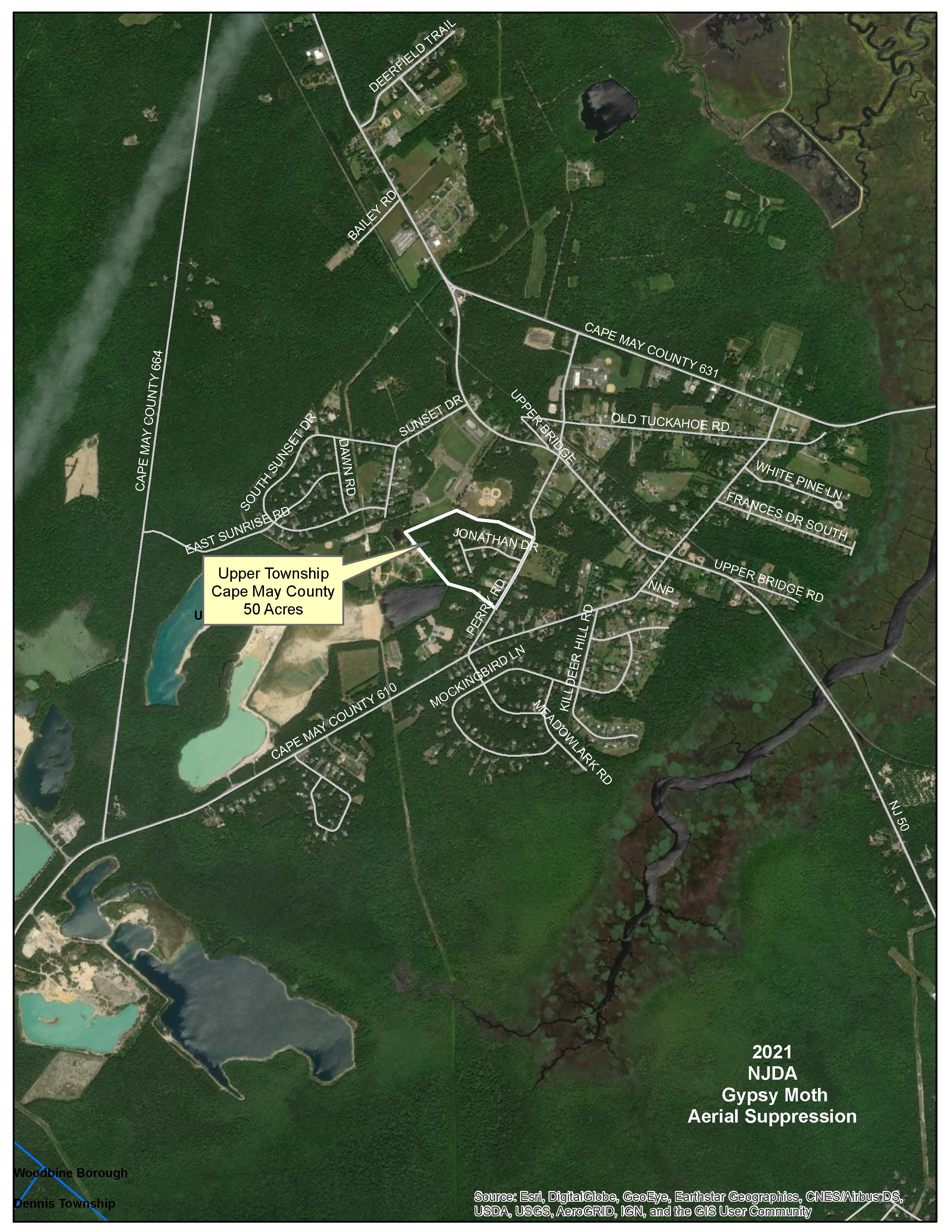The Lymantria dispar dispar (LDD - formerly known as gypsy moth) is the most destructive forest insect pest to infest New Jersey's forests. Repeated defoliation by LDD represents a serious threat to New Jersey woodland and shade tree resources. The New Jersey Department of Agriculture promotes an integrated pest management approach, which encourages natural controls to reduce LDD feeding and subsequent tree loss. However, when LDD cycles are at a peak, natural controls have difficulty in preventing severe defoliation. In these special cases, the Department recommends aerial spray treatments on residential and recreational areas using the selective, non-chemical insecticide, Bacillus thuringiensis. The Department's LDD Suppression Program is a voluntary cooperative program involving New Jersey municipalities, county agencies, state agencies, and the USDA Forest Service. The USDA's Self-Inspection LDD Checklist is available here. In order to protect New Jersey's valuable forest resources, the Department conducts aerial defoliation and ground egg mass surveys, monitors the application and evaluates the efficacy of the spray material.
- 2024 LDD Suppression Program
- 2023 LDD Suppression Program
- 2022 LDD Suppression Program
- 2021 LDD Suppression Program
- 2020 Gypsy Moth Suppression Program
- 2019 Gypsy Moth Suppression Program
- 2018 Gypsy Moth Suppression Program
- 2017 Gypsy Moth Suppression Program
- 2016 Gypsy Moth Suppression Program
- 2015 Gypsy Moth Suppression Program
- 2014 Gypsy Moth Suppression Program
- 2013 Gypsy Moth Suppression Program
- 2012 Gypsy Moth Suppression Program
- 2011 Gypsy Moth Suppression Program
- 2010 Gypsy Moth Suppression Program
- 2009 Gypsy Moth Suppression Program
- 2008 Gypsy Moth Suppression Program
- 2007 Gypsy Moth Suppression Program
- Program Details
- Gypsy Moth Information
- 2024 LDD Suppression Program
Town by Town Spray Zone List
Indiividual Township Spray Area Maps
Cape May County
Dennis Township
Upper TownshipSussex County
Montague
State Lands - High Point and Stokes
Burlington County
Bass River TownshipPassaic County
State Lands - Ringwood

- 2023 LDD Suppression Program
2023 LDD Aerial Defoliation SurveyTown by Town Spray Zone List
All treatments have been concluded as of May 22, 2023
Indiividual Township Spray Area Maps
Middle Township
Washington Township (Burlington County)
Bass River Township
Southampton Township
Woodland and Manchester Township
Dennis Township
Upper Township

- 2022 LDD Suppression Program
2022 NJ LDD Aerial Defoliation Survey and Map

- 2021 LDD Suppression Program
Department staff have completed the statewide municipal egg mass survey for LDD populations. From the surveys, a total of 170 acres in two blocks located in Burlington and Cape May County had been proposed for treatment during the spring of 2021. The municipality in Burlington County opted not to participate on the program leaving 50 acres in Cape May County for treatment.The New Jersey Department of Agriculture and Upper Township, Cape May County, is planning to conduct an aerial treatment for LDD on 50 acres located on Route 50 during the spring of 2021 using Btk. Treatments are planned to occur in the early morning, weather permitting, anytime during the month of May. Residents interested in the actual date and timing of treatment should contact their local municipal clerk’s office for more detail. A map of the treatment area can be found below.

- 2020 Gypsy Moth Suppression Program
2020 NJ Gypsy Moth Aerial Defoliation Survey and Map

- 2019 Gypsy Moth Suppression Program
2019 NJ Gypsy Moth Aerial Defoliation Survey and Map

- 2018 Gypsy Moth Suppression Program

- 2017 Gypsy Moth Suppression Program
2017 NJ Gypsy Moth Aerial Defoliation Survey and Map (740K PDF) - 2016 Gypsy Moth Suppression Program
2016 NJ Gypsy Moth Aerial Defoliation Survey and Map

- 2015 Gypsy Moth Suppression Program
2015 Gypsy Moth Aerial Defoliation Survey and Statewide Aerial Defoliation Map (348K PDF)

- 2014 Gypsy Moth Suppression Program
2014 Gypsy Moth Aerial Defoliation Survey and Statewide Aerial Defoliation Map

- 2013 Gypsy Moth Suppression Program
2013 Gypsy Moth Aerial Defoliation Survey and Statewide Aerial Defoliation Map

- 2012 Gypsy Moth Suppression Program
2012 Gypsy Moth Aerial Defoliation Survey and Statewide Aerial Defoliation Map

- 2011 Gypsy Moth Suppression Program
2011 New Jersey Gypsy Moth Aerial Defoliation Survey and Statewide Aerial Defoliation Map
2011 Gypsy Moth Spray Zones and Static Maps

- 2010 Gypsy Moth Suppression Program
2010 New Jersey Gypsy Moth Aerial Defoliation Survey Results and Statewide Aerial Defoliation Map

- 2009 Gypsy Moth Suppression Program
2009 New Jersey Gypsy Moth Aerial Defoliation Survey Results and Statewide Aerial Defoliation Map

- 2008 Gypsy Moth Suppression Program
2008 New Jersey Gypsy Moth Aerial Defoliation Survey Results and Statewide Aerial Defoliation Map

- 2007 Gypsy Moth Suppression Program
2007 New Jersey Gypsy Moth Aerial Defoliation Survey Results
2007 Statewide Aerial Defoliation Map

- Program Details
Voluntary LDD Suppression Program Regulations
Model newspaper notice - Northern Counties (33K DOC)
Model newspaper notice - Soutthern Counties (33K DOC)
Model resident notice - Northern Counties (35K DOC)
Model resident notice - Southern Counties (35K DOC)

- Gypsy Moth Information
Finding a pesticide applicator to control gypsy moth. This link takes you to the NJDEP Data Miner Pesticides page. Click on the item that says "Applicator Businesse by Types of Pest Control Performed. Once on the Pesticide Applicator Search Page, select your county and then either ornamental, shade trees or forests to find applicators to control gypsy moth.
You may also check your local Yellow Pages for "arborists."
Fact Sheets:
For the Homeowner
General Information



